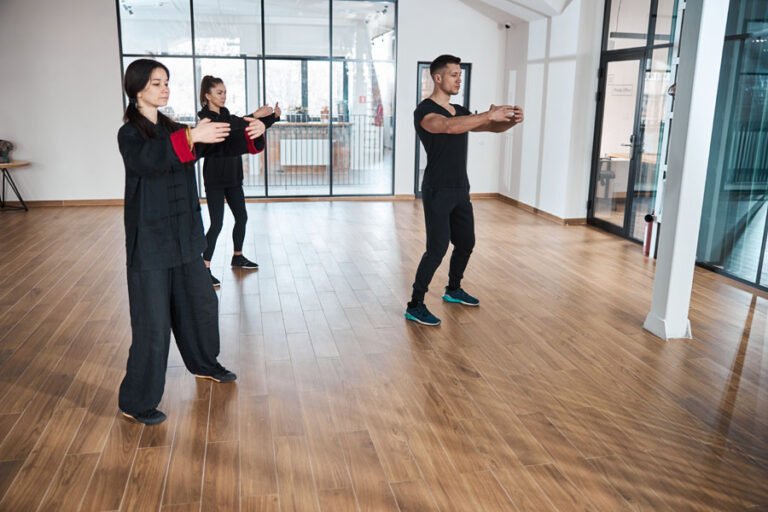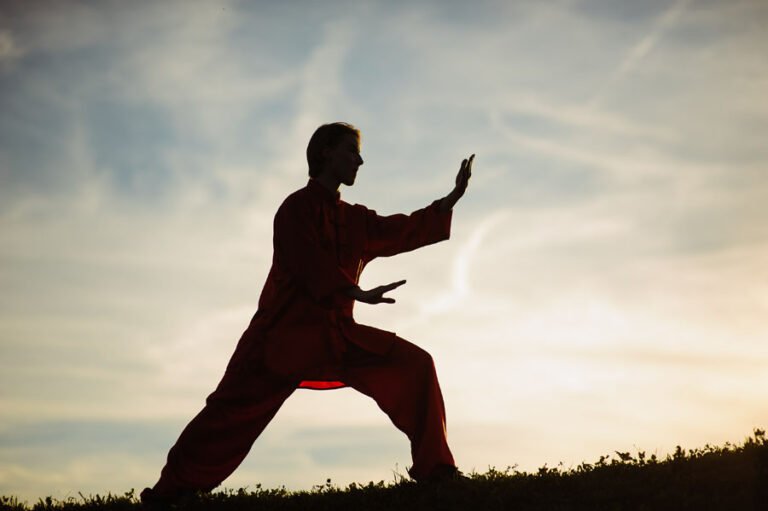Know The Difference: Qigong vs Tai Chi

Are you looking to get into the world of mind-body practices, but not entirely sure which one is right for you? It can be hard to figure out what makes Qigong different from Tai Chi. Both offer amazing physical and mental benefits – so how do you even begin to choose between them? Don’t worry! In this blog post, we’ll break down all the key differences between Qigong and Tai Chi.
We’ll cover everything from their origins and practice methods to their primary health benefits. By the time you finish reading, you’ll have a much better understanding on which practice is best suited for your needs. So let’s dive in!
Deepen Your Understanding of Qigong and Tai Chi
If you’re interested in deepening your understanding of Qigong and Tai Chi, it’s important to know the difference between the two practices. At Green Frog Tai Chi, we offer one free complimentary class of Qigong and Tai Chi so you can experience the benefits of these ancient practices for yourself. Don’t hesitate to learn more and start your journey towards better health today!

Defining Qigong and Tai Chi - What Are They, and How Are They Different
Do you know the difference between qigong and tai chi? Both practices are rooted in Chinese philosophy and aim to improve the health and well-being of the practitioner. Qigong involves a combination of breathing techniques, physical movements, and meditation to cultivate and balance the body’s energy, or “qi”.
Tai chi, on the other hand, focuses on a sequence of slow, fluid movements that promote relaxation and harmony. While both qigong and tai chi may have similar benefits, such as reducing stress and improving flexibility, they have distinct differences in their approach and execution. And when it comes to what to wear for qigong or tai chi practice, loose, comfortable clothing is recommended to allow for freedom of movement and ease of breath.
What is Qigong
If you’ve heard of tai chi, then chances are you’ve also come across qigong. While tai chi uses smooth movements and controlled breathing to promote relaxation, qigong is rooted in the practice of energy work. Qigong is an ancient Chinese exercise that focuses on cultivating and balancing the body’s natural energy, known as qi or chi.
With various movements, breathing techniques, and meditation, qigong aims to promote overall well-being and enhance the mind-body connection. So, if you’re interested in exploring energy work and movement practices, give qigong a try. And when attending a qigong class, choose comfortable clothing that allows you to move freely and breathe deeply.

What is Tai Chi
Tai Chi is a gentle and healing movement practice that has been around for centuries. It is typically performed outdoors in comfortable clothing that allows for free range of motion. Tai Chi movements are slow and flowing, allowing practitioners to connect with their life force energy and promote internal harmony.
While it may look like a dance, Tai Chi has its roots in martial arts and can be used for self-defense. Practicing the Tai Chi form helps improve balance, coordination, and overall well-being
The History of Qigong and Tai Chi
Tai Chi and Qigong are ancient Chinese practices that focus on the cultivation of inner peace and well-being. While both involve the use of breath and movement, they have distinct differences. Tai Chi is a martial art that emphasizes slow and controlled movements, whereas Qigong focuses on breathing techniques, meditation, and visualization exercises to promote inner harmony and balance.
The origins of both practices can be traced back thousands of years, and both have been adopted and adapted over time.
History of Qigong
Qigong, an ancient practice deeply embedded in the cultural tapestry of China, traces its origins back to the reign of the legendary Yellow Emperor, believed to be around 2696-2598 BCE. Regarded as a significant figure in traditional Chinese medicine, the Yellow Emperor’s era marks the birth of Qigong. However, it’s important to note that early forms of Qigong differed from the practices we know today. They resembled animal dances, possibly performed to counter the effects of the cold and damp climate in ancient China.
One of the earliest documented forms of exercise resembling modern Qigong was Dao Yin, which emerged in ancient China. Combining physical movements with mental focus and controlled breathing, Dao Yin laid the groundwork for the evolution of Qigong. Notably, researchers at the Shanghai Qi Gong Research Institute suggest that Qigong likely originated from the dances performed by early Wu Shaman.
As time passed, Qigong became an integral part of traditional Chinese medicine. The practice involves utilizing exercises to cultivate and balance qi, also known as “life energy.” While specific techniques and practices may vary, the fundamental principle of harmonizing the body’s energy remains constant.
Throughout its history, Qigong has evolved and flourished. It was initially documented in Taoist writings around 600 CE, highlighting its close association with Taoist philosophy and practices. From there, Qigong continued to expand and adapt, influenced by the prevailing religious, philosophical, and medical concepts of each era.
History of Tai Chi
The fascinating history of Tai Chi, also known as Taijiquan, is a captivating blend of historical facts and traditional Chinese cultural mythology. This ancient martial art’s origins are veiled in mystery, deeply rooted in Chinese history, Taoism, and Confucianism.
One theory suggests that Tai Chi was created by Chen Wangting (1580–1660), a retired warrior residing in Chen Village, Henan. After the fall of the Ming Dynasty, Chen turned to a peaceful life as a farmer. Legend has it that he merged his martial knowledge with Taoist principles and traditional Chinese medical theories, giving birth to a unique form of martial arts that eventually evolved into what we now call Tai Chi.
Another captivating tale credits the creation of Tai Chi to Zhang Sanfeng, a 12th-century Taoist monk. While the historical existence of Zhang Sanfeng is debated, the story goes that he saw a fight between a snake and a crane, drawing inspiration from the snake’s ability to subtly and swiftly evade the crane’s attacks. This led him to develop the principles of Tai Chi, emphasizing flexibility and yielding in the face of aggression.
Regardless of its exact origins, Tai Chi first appeared in written records in the “Yì Jīng” (易经), one of the oldest Chinese classic texts describing an ancient system of cosmology and philosophy. From these early mentions, Tai Chi has grown and transformed over centuries.
Tai Chi is characterized by its soft, slow, and continuous movements, balanced by firm and fast ones. It incorporates flowing and rhythmic exercises designed to promote relaxation, inner calm, and peace. While the original form of Tai Chi included leaps, stamping, and bursts of sudden movements, it has gradually shed its fiercer elements in favor of a more tranquil and meditative form.
Over the past 700 to 1500 years, Tai Chi has evolved from a martial art into a comprehensive system of physical exercise, breathing control, and meditation. Practiced by millions worldwide, it is a form of Qigong (Chi Kung) renowned for its health benefits, including stress reduction, improved balance and posture, enhanced cardiovascular health, uplifted mood, increased energy, and overall well-being.

The Benefits of Each Practice
Tai Chi and Qigong are two practices often confused with each other. While they share similar principles and are both rooted in Chinese tradition, they are distinct practices. Tai Chi is a martial art that focuses on slow, deliberate movements and is often used as a form of meditation and exercise. Qigong, on the other hand, is a series of movements that combine breathing techniques with meditation. Both practices have numerous benefits, including improved flexibility, balance, and mental wellbeing.
Qigong Benefits
- Improved fitness levels
- Reduction in anxiety and depression symptoms.
- Relief from chronic pain.
- Strengthening of the immune system.
- Increased focus and reduced stress.
- Enhanced mood and energy levels.
- Reduced symptoms of chronic fatigue.
- Improved circulation to muscles and organs.
- Harmonization and strengthening of internal organs and bodily systems.
- Increased supply and flow of Qi (life energy).
Tai Chi Benefits
- Stress reduction.
- Improved balance and postural alignment.
- Enhanced cardiovascular health.
- Improved mood and increased energy levels.
- Overall well-being.
- Better flexibility and agility.
- Improved muscle strength and definition.
- Enhanced cognitive function.
- Reduction in symptoms of depression and anxiety.
- Improved circulation to muscles and organs.
What Can You Expect from Qigong and Tai Chi
When it comes to energy work, Qigong and Tai Chi are two practices that are often mentioned in the same breath. Both of them incorporate deep breathing, slow movements, and meditation in their practice. Qigong practitioners put emphasis on the cultivation and movement of energy, while Tai Chi is more focused on martial arts applications and body alignment.
In terms of what to wear, loose, comfortable clothing that allows for proper movement is recommended for both practices. It’s important to remember that while both Qigong and Tai Chi can be physically demanding, they are low-impact practices that can be tailored to suit individual needs and abilities.
Conclusion
In conclusion, understanding the difference between Qigong and Tai Chi can help you determine which practice is best for your needs. While both utilize movements and breathing techniques to improve balance, flexibility, and overall health, Tai Chi is more of a martial art with flowing movements while Qigong is focused more on energy cultivation and meditation.
It’s important to keep in mind that both practices have numerous benefits and can be a valuable addition to your wellness routine. Regardless of which one you choose, consistent practice can lead to increased relaxation and improved physical and mental well-being.
